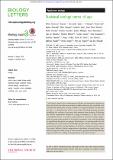Files in this item
Statistical ecology comes of age
Item metadata
| dc.contributor.author | Gimenez, Olivier | |
| dc.contributor.author | Buckland, Stephen Terrence | |
| dc.contributor.author | Morgan, Byron J. T. | |
| dc.contributor.author | Bez, Nicolas | |
| dc.contributor.author | Bertrand, Sophie | |
| dc.contributor.author | Choquet, Remi | |
| dc.contributor.author | Dray, Stephane | |
| dc.contributor.author | Etienne, Marie-Pierre | |
| dc.contributor.author | Fewster, Rachel | |
| dc.contributor.author | Gosselin, Frederic | |
| dc.contributor.author | Merigot, Bastien | |
| dc.contributor.author | Monestiez, Pascal | |
| dc.contributor.author | Morales, Juan M. | |
| dc.contributor.author | Mortier, Frederic | |
| dc.contributor.author | Munoz, Francois | |
| dc.contributor.author | Ovaskainen, Otso | |
| dc.contributor.author | Pavoine, Sandrine | |
| dc.contributor.author | Pradel, Roger | |
| dc.contributor.author | Schurr, Frank M. | |
| dc.contributor.author | Thomas, Len | |
| dc.contributor.author | Thuiller, Wilfried | |
| dc.contributor.author | Trenkel, Verena | |
| dc.contributor.author | de Valpine, Perry | |
| dc.contributor.author | Rexstad, Eric | |
| dc.date.accessioned | 2015-02-20T14:31:01Z | |
| dc.date.available | 2015-02-20T14:31:01Z | |
| dc.date.issued | 2014-12-24 | |
| dc.identifier | 169367761 | |
| dc.identifier | 829aea79-6e6a-4d4d-97d0-ac76dfed26e8 | |
| dc.identifier | 84953641166 | |
| dc.identifier | 000361337600002 | |
| dc.identifier.citation | Gimenez , O , Buckland , S T , Morgan , B J T , Bez , N , Bertrand , S , Choquet , R , Dray , S , Etienne , M-P , Fewster , R , Gosselin , F , Merigot , B , Monestiez , P , Morales , J M , Mortier , F , Munoz , F , Ovaskainen , O , Pavoine , S , Pradel , R , Schurr , F M , Thomas , L , Thuiller , W , Trenkel , V , de Valpine , P & Rexstad , E 2014 , ' Statistical ecology comes of age ' , Biology Letters , vol. 10 , 20140698 . https://doi.org/10.1098/rsbl.2014.0698 | en |
| dc.identifier.issn | 1744-9561 | |
| dc.identifier.other | ORCID: /0000-0002-7436-067X/work/29591676 | |
| dc.identifier.other | ORCID: /0000-0002-4323-8161/work/29574861 | |
| dc.identifier.other | ORCID: /0000-0002-9939-709X/work/73701018 | |
| dc.identifier.uri | https://hdl.handle.net/10023/6128 | |
| dc.description.abstract | The desire to predict the consequences of global environmental change has been the driver towards more realistic models embracing the variability and uncertainties inherent in ecology. Statistical ecology has gelled over the past decade as a discipline that moves away from describing patterns towards modelling the ecological processes that generate these patterns. Following the fourth International Statistical Ecology Conference (1 –4 July 2014) in Montpellier, France, we analyse current trends in statistical ecology. Important advances in the analysis of individual movement, and in the modelling of population dynamics and species distributions, are made possible by the increasing use of hierarchical and hidden process models. Exciting research perspectives include the development of methods to interpret citizen science data and of efficient, flexible computational algorithms for model fitting. Statistical ecology has come of age: it now provides a general and mathematically rigorous framework linking ecological theory and empirical data. | |
| dc.format.extent | 4 | |
| dc.format.extent | 283824 | |
| dc.language.iso | eng | |
| dc.relation.ispartof | Biology Letters | en |
| dc.subject | Citizen science | en |
| dc.subject | Hidden Markov model | en |
| dc.subject | Hierarchical model | en |
| dc.subject | Movement ecology | en |
| dc.subject | Software package | en |
| dc.subject | GE Environmental Sciences | en |
| dc.subject | QA Mathematics | en |
| dc.subject.lcc | GE | en |
| dc.subject.lcc | QA | en |
| dc.title | Statistical ecology comes of age | en |
| dc.type | Journal article | en |
| dc.contributor.sponsor | EPSRC | en |
| dc.contributor.institution | University of St Andrews. School of Mathematics and Statistics | en |
| dc.contributor.institution | University of St Andrews. Marine Alliance for Science & Technology Scotland | en |
| dc.contributor.institution | University of St Andrews. Scottish Oceans Institute | en |
| dc.contributor.institution | University of St Andrews. St Andrews Sustainability Institute | en |
| dc.contributor.institution | University of St Andrews. Centre for Research into Ecological & Environmental Modelling | en |
| dc.contributor.institution | University of St Andrews. Statistics | en |
| dc.identifier.doi | 10.1098/rsbl.2014.0698 | |
| dc.description.status | Peer reviewed | en |
| dc.identifier.grantnumber | EP/I000917/1 | en |
This item appears in the following Collection(s)
Items in the St Andrews Research Repository are protected by copyright, with all rights reserved, unless otherwise indicated.

